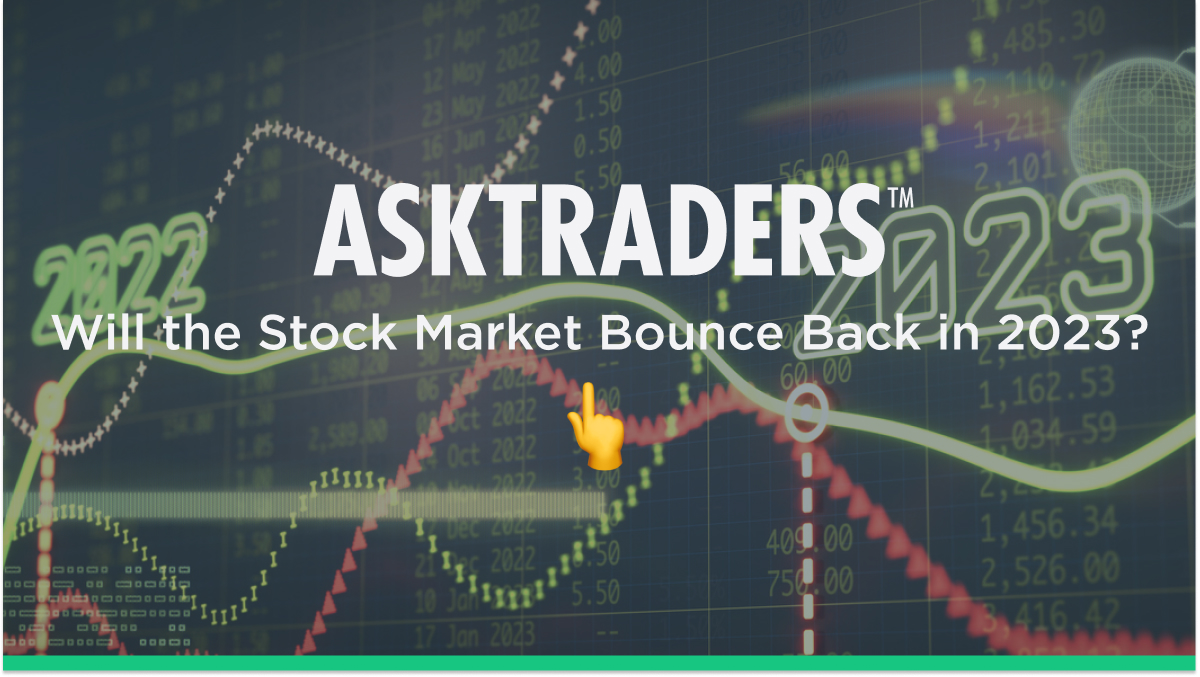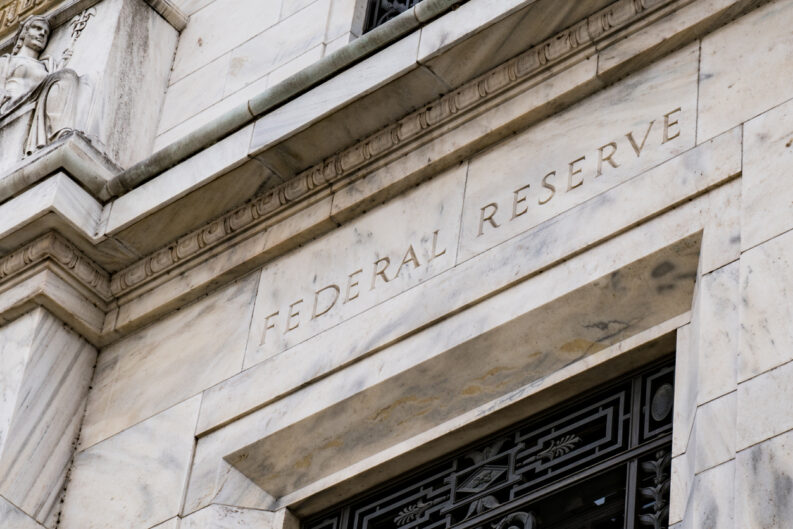The global economy is enthralled by the US. As the largest consumer and free-market economy built upon the most pervasive payments network and largest reserve currency ever devised, when considering whether to invest in the stock market, one must first turn to the US for guidance, and ask will the stock market bounce back in 2023?

eToro is a multi-asset investment platform. The value of your investments may go up or down. Your capital is at risk.
At the centre of this super-sized pile of capital sits the US Federal Reserve (Fed). Acting as the nation’s central bank, the Fed sets the US Dollar benchmark lending and borrowing rates, designed to influence prices in order to ensure a fair and orderly market is conducted.
In 2022 under pressure to rein in inflation unleashed by labour, raw material, and parts shortages, the Fed has rapidly raised interest rates from an era of incentivised near-zero funding.
The temporary shortages could be attributed to pandemic-era low inventories, then exacerbated by Russian and Ukrainian supply displacement. The low-interest rate environment was implemented, amongst other reasons, upon immaterialised fears of a complete seizure in capital investment during the pandemic-era mandates on the movement of people.
The sharp rise in interest rates has sent shockwaves through the corporate debt and equity markets. The corporate debt market has had its worst year on record, with the Vanguard Total Bond Market ETF NYSE:BND (BND) declining over 14% from the start of 2022.
The elevated borrowing costs and volatility in shares have made raising capital more difficult, stymying investment and threatening future personnel hiring.
If we are to see a sustained rally in stock markets, we will first need to see a shift to a more graduated series of rate hikes, stability in stock markets will follow, facilitating a balanced capital raising environment. This, in turn, will feed the investment and hiring cycle and power the economies of the world forward.
Read on as we explore the contributing factors that may serve to influence a potential bounce back in the stock markets in the coming year.
Table of contents
The Fed
The US Federal Reserve has already signalled a graduation in the rate hike cycle for 2023, assessing that their sharp rises in interest rates are already starting to pressure inflation.
The layperson can witness this effect in the readily available Consumer Price Index (CPI) data already published. Rental prices are commencing a decline across the US – energy stock prices are 30% or lower than in June of this year and agreements over agricultural supply via the Black Sea have taken the sting out of wheat and seed oils.
Isolated pockets, including education and airfare, remain stubbornly high. Labour shortages and inflation-linked wage inflation may take longer to wash out, providing stubborn resistance to the Fed’s price actions.
On balance, the US Federal Reserve is winning the battle against inflation but may need to keep interest rates higher for longer. That is not to say the stock market can’t thrive without a complete reversal in interest rate policy – certain sectors will perform better than others.

eToro is a multi-asset investment platform. The value of your investments may go up or down. Your capital is at risk.
Here are four sectors, each selected for their likelihood to benefit from a ‘higher-for-longer’ rate environment into 2023:
Banks
Banks, in their simplest form, take depositor money and loan it out at an interest rate composed first of a central bank benchmark, plus their own rate add-ons and fees depending on the credit quality of the client.
The rate at which money is loaned will typically be higher than paid to the savers, giving the bank a return. The nature of scaled operations has it that the loan rate is a certain number of percentage points higher than the saving rate. Therefore, as rates rise, the difference between the loan and deposit rates increases.
By extension, as interest rates rise, the gross dollars in revenue for banks increases. With this simple mechanism, banks favour raising interest rates. It increases their top line and makes their operations more valuable.
Provided unemployment remains subdued, customer credit quality will remain sufficiently high to negate the requirement to raise credit loss provisioning, maintain the bottom line and provide room for shareholder disbursements via dividends and buybacks.
Should you wish to dip your toe in the banking sector, dependent upon your geographic preference, one can’t go too far wrong with either JP Morgan & Chase Co. NYSE:JPM (JPM) or Lloyds Banking Group plc LSE:LLOY (LLOY).
Insurers
Insurers are able to generate income in much the same fashion as banks, though instead of deposits, it is insurance premiums and annuity funding as the input. With the appropriate regulatory capital set aside to cover a rush of potential pay-outs, the remainder of the funds made available to the insurer is put to work in the capital markets. A great majority is lent to blue-chip American companies tapping the debt markets and the US government via treasury security notes.
The Fed raising rates is a tide that lifts all ships for the buyer in debt markets. The debt instruments become cheaper to insurers and provide higher coupons and greater returns on maturity. The improved returns on new capital allocations in time will improve the annual profits of both banks and insurers, feeding through to higher stock valuations.
If you’re of the opinion that the insurance market will avoid calamity in 2023 via markedly higher unemployment insurance pay-outs, or an above-median outcome of natural disasters over the course of the year, then an insurance company stock investment might be the one for you.
One might consider the UK’s largest insurer, Admiral Group plc LSE:ADM (ADM), or in the US, traders have the access to the high entry point required, Berkshire Hathaway NYSE:BRK-A (BRK-A). An alternative to the expensive BRK-A is the more attainable BRK-B, currently listed at $315/share.
Consumer Discretionary
The forecast might be for an environment of stubbornly high inflation relative to previous years – this shouldn’t turn you off all retail sectors. As prices rise, some retailers will be forced to raise their prices to accommodate the acquisition costs and their margins.
High prices might turn off some buyers but with a stable level of employment across the world. Most consumers will return to replace or upgrade white goods, take advantage of the latest in telecoms, and continue to go on the annual trip abroad. Any slight moderation in volume for the retailer will be countered by higher dollar value margins.
Another strategy employed by the modern retailer when prices are rising is the introduction or marketing of buy-now-pay-later mechanisms. These offer the customer the opportunity to pay in instalments rather than upfront, while charging an interest rate over the duration of payment.
Adjusting prices and varying the mechanisms of settlement enables consumer discretionary to take advantage of higher prices for longer.
One might consider in the UK Currys plc LSE:CURY (CURY), and in the US, Macy’s Inc NYSE:M (M) if you believe the consumer to remain robust through 2023.

eToro is a multi-asset investment platform. The value of your investments may go up or down. Your capital is at risk.
Education
If, as chairman and CEO of JP Morgan Jamie Dimon has stated, the economy could tip into recession in 2023, there are but a few areas that will provide a secure location for your capital.
Benjamin Franklin famously stated, “….nothing is certain except death and taxes” (source: Constitutioncenter.org). Had he been referring to investments, he might have rephrased that to ‘education and healthcare’.
Both education and healthcare, under a growing population base, are the two sectors that will continue to see growth in some shape or form. Their defensive nature makes them particularly secure places to house your funds when the rest of the market is turning sour.
Whether it’s the upskilling of the recently unemployed or the vast multitudes of those entering higher education every year, education never loses its lustre as a means to branch out or get back on your feet. Providing solid year-round growth to the prospective investor.
Two stocks worth considering in this space are Bright Horizons Family Solutions Inc NYSE:BFAM (BFAM) and Chegg Inc NYSE:CHGG (CHGG). Both are well positioned in the consumer defensive sector and, irrespective of price or unemployment levels, will always find customers willing to take up their goods and services in order to get on in this world.
Final Thoughts
Investing in stocks, even applying sound risk management strategies and spreading your investments across a range of holdings or ETFs, is not without risks. Even the most experienced portfolio and risk managers will find certain market environments difficult to return a profit in.
Only invest what is comfortably within your budget and, preferably, do it at regular intervals such that the entry point becomes so overshadowed that it becomes irrelevant.
Always do your own due diligence and consult with the experts where you can. At Asktraders, we have a wealth of data and information for you, alongside our listings of expertly selected stock brokers, to ensure you read up and understand what you’re getting into before you make any investment decision.













